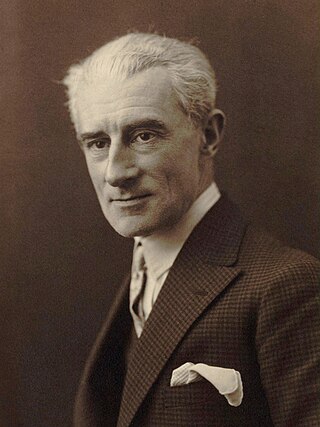Related Research Articles

Joseph Maurice Ravel was a French composer, pianist and conductor. He is often associated with Impressionism along with his elder contemporary Claude Debussy, although both composers rejected the term. In the 1920s and 1930s Ravel was internationally regarded as France's greatest living composer.

Francis Jean Marcel Poulenc was a French composer and pianist. His compositions include songs, solo piano works, chamber music, choral pieces, operas, ballets, and orchestral concert music. Among the best-known are the piano suite Trois mouvements perpétuels (1919), the ballet Les biches (1923), the Concert champêtre (1928) for harpsichord and orchestra, the Organ Concerto (1938), the opera Dialogues des Carmélites (1957), and the Gloria (1959) for soprano, choir, and orchestra.

Roger Désormière was a French conductor. He was an enthusiastic champion of contemporary composers, but also conducted performances of early eighteenth century French music.

Boléro is a 1928 work for large orchestra by French composer Maurice Ravel. At least one observer has called it Ravel's most famous composition. It was also one of his last completed works before illness forced him into retirement.
Wilfred Josephs was an English composer.

Les Sylphides is a short, non-narrative ballet blanc to piano music by Frédéric Chopin, selected and orchestrated by Alexander Glazunov.
Jean René Désiré Françaix was a French neoclassical composer, pianist, and orchestrator, known for his prolific output and vibrant style.

L'enfant et les sortilèges: Fantaisie lyrique en deux parties is an opera in one act, with music by Maurice Ravel to a libretto by Colette. It is Ravel's second opera, his first being L'heure espagnole. Written from 1917 to 1925, L'enfant et les sortilèges was first performed in Monte Carlo in 1925 conducted by Victor de Sabata.
Lera Auerbach is a Soviet-born Austrian-American classical composer, conductor and concert pianist.

Aribert Reimann is a German composer, pianist and accompanist, known especially for his literary operas. His version of Shakespeare's King Lear, the opera Lear, was written at the suggestion of Dietrich Fischer-Dieskau, who sang the title role. His opera Medea after Grillparzer's play premiered in 2010 at the Vienna State Opera. He was a professor of contemporary Lied in Hamburg and Berlin. In 2011, he was awarded the Ernst von Siemens Music Prize for his life's work.

The Requiem, Op. 9, is a 1947 setting of the Latin Requiem by Maurice Duruflé for a solo voice, mixed choir, and organ, or orchestra with organ. The thematic material is mostly taken from the Mass for the Dead in Gregorian chant. The Requiem was first published in 1948 by Durand in an organ version.

La valse, poème chorégraphique pour orchestre, is a work written by Maurice Ravel between February 1919 and 1920; it was first performed on 12 December 1920 in Paris. It was conceived as a ballet but is now more often heard as a concert work.
Ragnar Søderlind is a Norwegian composer. He has written ballets and operas, and for the concert hall, programmatic works based on poems.
Stella Zambalis is an American spinto soprano born in Cleveland, Ohio. She has been called one of the best sopranos in the world today.
Vienna Waltzes is a ballet choreographed by George Balanchine to music by Johann Strauss II, Franz Lehár and Richard Strauss, made as a tribute to Austria. It premiered on June 23, 1977 at the New York State Theater, performed by the New York City Ballet, and was an immediate success among the public.

Introduction and Allegro for Harp, Flute, Clarinet and String Quartet is a chamber work by Maurice Ravel. It is a short piece, typically lasting between ten and eleven minutes in performance. It was commissioned in 1905 by the Érard harp manufacturers to showcase their instruments, and has been described as a miniature harp concerto. The premiere was in Paris on 22 February 1907.
Sonatine is a ballet choreographed by George Balanchine to Ravel's eponymous music. The ballet was made for the New York City Ballet's Ravel Festival, which celebrated the centenary of Ravel, and premiered on May 15, 1975, at the New York State Theater, following a preview performance the previous day. The ballet was originated by Violette Verdy and Jean-Pierre Bonnefoux.

The orchestral Dance Suite from Keyboard Pieces by François Couperin, TrV 245 was composed by Richard Strauss in 1923 and consists of eight movements, each one based on a selection of pieces from François Couperin's Pièces de Clavecin written for the solo harpsichord over the period 1713 to 1730. It is also sometimes referred to as simply The Couperin Suite.

Alborada del gracioso is a short orchestral piece by Maurice Ravel first performed in 1919. It is an orchestrated version of one of the five movements of his piano suite Miroirs, written in 1904–05. Originally created for a ballet, the work has entered the concert repertoire, and has been recorded frequently.
Jean Doyen was a French classical pianist, pedagogue and composer.
References
- ↑ "American Harp Society Tape Library" (PDF). Retrieved 2022-10-19.
- Ruppenthal, Stephen, and David Patterson. 2001. "Moran, Robert (Leonard)". The New Grove Dictionary of Music and Musicians, second edition, edited by Stanley Sadie and John Tyrrell. London: Macmillan Publishers.
- Tyranny, "Blue Gene", and Anonymous. 2008. "Robert Moran: Conductor". All Media Guide, LLC. (Accessed July 14, 2013).